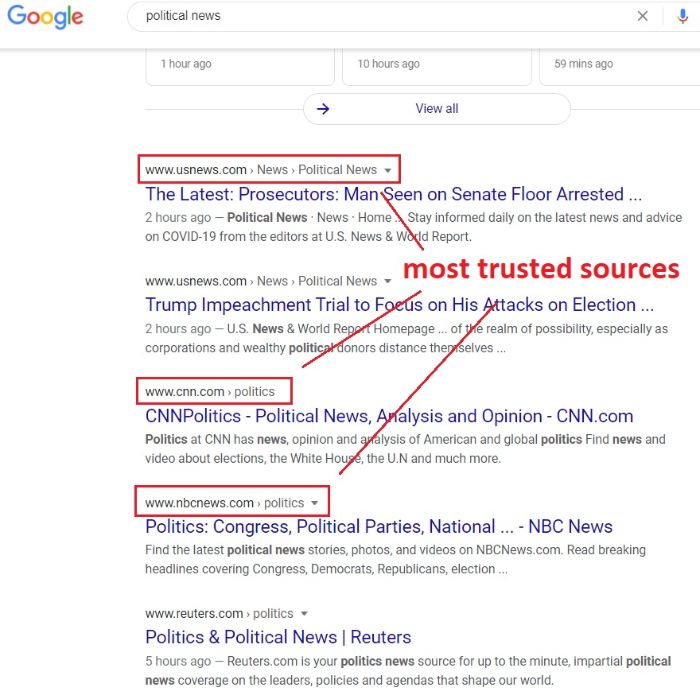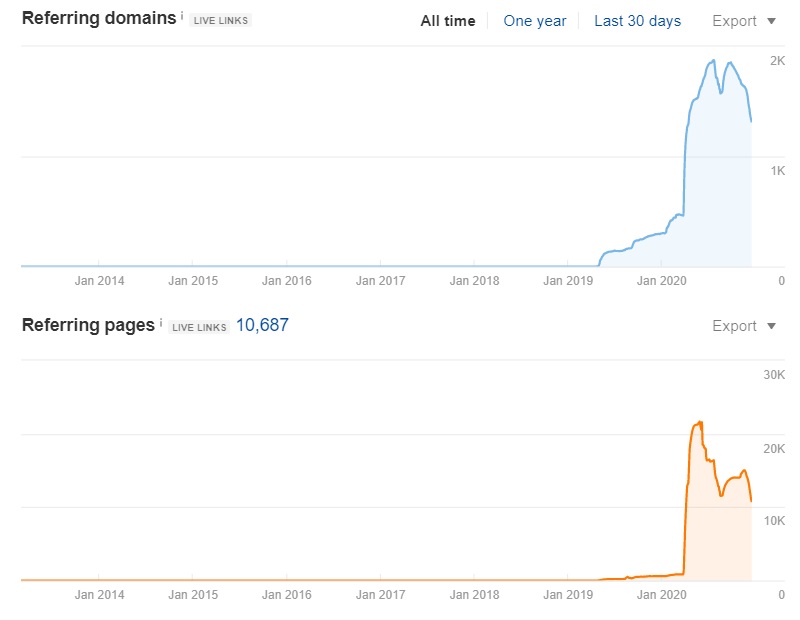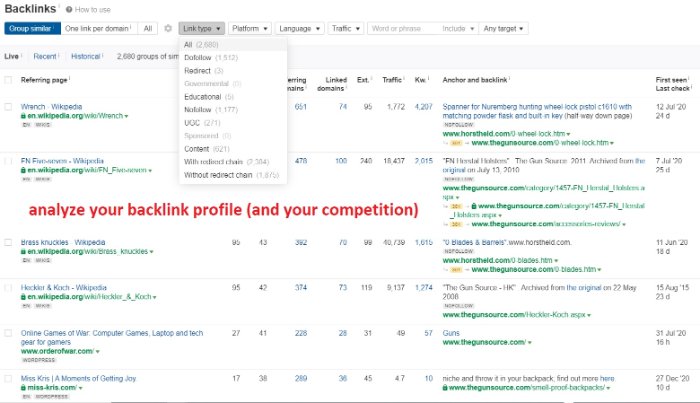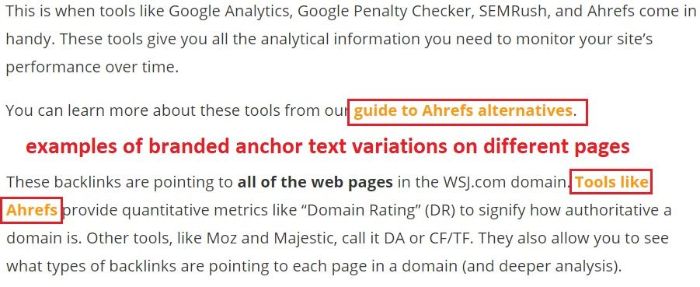How Many Backlinks Should A Website Have?
Join the 1,000+ brands that trust us for their link building.
Backlinks are the most important ingredients that influence a site’s rankings. It’s normal to assume that it’s always better to have more of a good thing, so people think acquiring as many backlinks as possible is the best link building strategy for ranking. In reality, this assumption isn’t always true and can even get you in trouble.
Quantity isn’t always better than quality when it comes to building links. There are countless examples of pages outranking other pages for a target keyword with less overall backlinks. This is because there are several factors that determine how well a page ranks, and the quantity of backlinks is just part of the total package (and often isn’t the most reliable indicator).
This article won’t focus too much on how many links a website should have per se. Instead, it’s going to discuss the importance of link building in general, why the number of backlinks you should have depends on your competition, and teach you how to perform an SEO analysis and acquire quality backlinks that will have a better impact on your website’s performance than just sheer quantity.
So how many backlinks do you need? It depends. I’m going to emphasize right now that there is no standard number of links any website should have. The number of backlinks your website should have really just depends on your competition and some other things that will be discussed in this article. Let’s take a look.
How Backlinks Increase Rank
Basically speaking, backlinks increase rank because they signal a vote of confidence in your website to search engines. If more people and sites are linking to your website, then search engines like Google will think your website is valuable and worth showcasing in the SERPs.
The more quality links to your website, the more valuable it appears to search engines, and eventually, your site will rank higher and you’ll get more organic traffic (of course there are other factors needed to rank well besides quality backlinks).
This is because search engines like Google want to showcase the best and most trusted sites for a given topic or search term. The best way to showcase these sites is to index and rank them on the first page of search results so users will find them instantly.
Most pages ranking on the first page of search results are considered trustworthy and authoritative. These attributes are quality factors. The trust and authority of a website is largely determined by its backlink profile, which is the total amount of incoming links to the domain (homepage) and inner pages, and the content displayed on these pages.

This is why the number of backlinks on a website is a relevant and legitimate concern for SEOs and website owners who want to rank as high as possible. But trust and authority aren’t determined solely by the number of backlinks.
Instead, these quality attributes are influenced by the type and composition of backlinks your website is receiving. Are your backlinks coming from authoritative websites? Were they acquired naturally? Do they have natural anchor text? Are they pointing to your homepage, target URL, or power pages? Are they relevant?
These are all the ways that a backlink’s quality is important for signaling to Google that your website is trusted, legitimate, authoritative, and thus worthy of being ranked in the SERPs.
A great way to determine the quality of a site’s backlink profile is to use a backlinks analysis tool to explore it and see how many links are pointing to target pages that are ranking in your niche. Let’s discuss ways you can explore and analyze your link profile and your competitor’s backlinks, and dive deeper into what you’ll need to build to rank well.
Ways to Analyze Backlinks
Whether you’re a beginner or a seasoned pro, analyzing backlinks (or referring domains) isn’t that difficult depending on how deep you want to go with your research. A quick check of a website’s backlink profile using a powerful tool like Ahrefs only takes a few minutes in most cases before you can arrive at a reasonable assessment of the site’s overall quality.

There are a few ways to analyze backlinks (some of which will be discussed in the following sections). You can look at the growth pattern of a site’s referring domains, the composition of those referring domains (e.g. Dofollow, governmental, educational), how many and what type of backlinks are coming from those referring domains (e.g. Dofollow, Nofollow, contextual, user-generated), and the actual referring pages those incoming links are coming from (are they relevant/authoritative or low quality/spammy).
You should do the same exploration of your competitor’s target sites. In fact, analyzing your competitors’ sites within your niche is one of the most important ways to analyze backlinks to determine how many you should be aiming for in general. The ideal number of backlinks for your website should depend on the number of backlinks your competition has. This consideration should be applied to the quality of your competitor’s backlink profiles too, and not just their quantity.
Try to match or exceed what your direct competitors have acquired for a target keyword in a given niche. If your competitors have a very natural and diverse link profile, with many links of various types (e.g. editorial links, guest posts, social media), then you won’t perform well against them if your site has very few links of mediocre quality coming from mostly user-generated content, images, or directories (for example).
An easy way to visualize this comparison is to search for a target keyword in Google and look at how many backlinks are pointing to the top 10 results on the first page SERP, as well as looking at how many of those backlinks are referencing the homepage or domain of those target URLs. This will give you a very easy method to quantify an estimate of how many backlinks you need for your website or target page when ranking for a specific keyword.
Other Things to Consider in Your Analysis
Now you can take your research as deep as you wish. Maybe you want to analyze the number of external links or organic traffic that each referring page that’s pointing to your site is receiving. All this is possible with Ahrefs, and a lot more. In most cases, we don’t think it’s necessary to dive that deep into analysis.
However, we do feel at a minimum you should look at the growth pattern and composition of backlinks to your homepage and most powerful pages, as well as your competition. This is part of assessing a site’s overall link profile to make sure it’s natural and diverse, which we will discuss further in this article. Also, having a lot of high-quality and diverse backlinks to your homepage is the ultimate sign of trust and authority to Google.
Sometimes you shouldn’t build a bunch of backlinks to a product or service page because that may come across as unnatural and manipulative to Google and adversely affect your ranking. Instead, you can use your trusted homepage or relevant, high quality content on a powerful content page to link and pass ranking power to a target page. Sometimes it’s more natural for a contextual link on a content page to link to another inner page rather than just having a bunch of random external links pointing to that page.
In other words, it looks better to have links pointing to the homepage of a trusted and authoritative site first, which can then link to another relevant inner page. It appears less targeted and manipulative that way, especially when those inner target pages are where financial transactions occur.
Once again, always apply these considerations to your direct competitors for comparison to get an idea of what you need to do. See how and where they are acquiring backlinks, or if they are building links to their homepage or target URLs.
You should be starting to understand that the most important question isn’t really how many backlinks you should have in total, but how many of each type you should have (i.e. diversity), where those backlinks are coming from and pointing to, and what your competition is doing for a target keyword in your niche.
Now that you’re aware that quality is more important than quantity, let’s discuss in further detail some of the variables you can analyze and modify to improve the quality and power of backlinks.

Variables that Make Backlinks More Effective
You want to try to maximize these variables as much as possible or follow a strategy that adheres to these guidelines and principles. They speak to the importance of quality over quantity.
Trust & Authority
The quality of a backlink (or a site’s backlink profile) has a lot to do with the trust and authority that’s associated with the link’s referring domain or page.
Trust and authority are very similar concepts. We consider authority to be one of the essential components of The Holy Trinity: Relevance, Authority, and Power.
Authority is related to the overall strength of a domain’s backlink profile. Once again, authority is about signaling trust and confidence to search engines like Google. That authority, or lack of authority, will be passed on to your website through backlinks and will either benefit or harm your site.
Generally speaking, a high authority domain will be more valuable to a backlink than the Power of the page the backlink is placed on (which is simply a measure of how many quality backlinks are pointing to that specific page instead of the entire domain). But this isn’t a hard rule and there are always exceptions.
So always aim to acquire links from the most authoritative (and relevant) websites possible. This is an example of how less can be more. A target URL with 10 of the most authoritative referring domains in a niche (e.g. leoburnett.com for photography or edmunds.com for automotive) is going to outperform a site with 1,000 random auto-generated links for that ranking factor (i.e. the referring domain authority) each and every time, all else equal.
However, if the page you’re trying to rank for is competing with 5 other sites with relatively similar backlink profiles (a good mixture of various types of high quality links), then you will want to focus on acquiring more of those high quality links. Don’t just focus on getting more overall links, but start focusing on building brand authority by getting more high quality links pointing to your homepage, for example.
All else equal, if you can get more quality links (perhaps with branded or URL anchors) pointing to your homepage or relevant content pages then you’re going to look better than another site that’s lacking in these types of links.

Content
It’s important to consider the value of content in increasing the trust and authority of a page a backlink is coming from.
Content is crucial to rank, for the obvious reason that people surf the internet primarily to be engaged by content. Google expects any website that’s trying to be authoritative to have great content. Moreover, content is often what people link to or from. Contextual backlinks are placed in content (such as guest posts) to direct users to other relevant URLs, such as a product page.
The most important ranking factors for content are its length and age. You’ll need just as many words on a topic as your competitors, or more, and you want that content to age for as long as possible on a site in order for it to gain power. Increasing organic traffic and building links to content pages is always a good idea.
All else equal, more content on your target URL is usually better when compared to your competitors or top performers in a SERP.
The Niche Your Site is In and It’s Competition
This is a perfect example of how the number of backlinks your website should have actually depends on the niche you’re competing in.
Which niche do you think will require more backlinks to be competitive in the SERPs: personal finance or fruit juggling? It’s pretty obvious which niche will attract the most interest and thus more websites, competitors, and content related to it.
The competition in your niche and how many quality backlinks they choose to build is an excellent reference on how to develop your link building strategy.
The general rule of thumb is the more competitive the niche, the more quality backlinks you’ll need on your homepage and inner pages. Choose wisely.
How Specific to that Niche Your Site Is
After you’ve chosen a niche, the next logical consideration is how niche-specific your website or target URLs are.
This idea is generally related to the Relevance factor of The Holy Trinity. Google wants to provide users with the most relevant search results for any given search term. That means the top-ranking pages in a SERP will tend to be highly specific, or relevant, to the target keyword they are ranking for. This benefits the search engine user.
These niche-specific pages will provide relevant and useful content. Their domains, URLs, SEO titles, content, h tags, anchor text, and meta descriptions will likely contain target/related keywords that identify a specific niche.
The more you drill down into a specific niche and optimize your target URL for a specific keyword associated with that niche, the easier it’s going to be to rank in the SERPs for that keyword (because there’s going to be less competition).
So ask yourself the following question before we move on. Which target URL is going to need more backlinks to rank for ‘hydrogenated soybean oil’: a site about Asian cooking or a research page about the effects of hydrogenation on soybean oil?
The site about Asian cooking will likely need a lot more overall backlinks because it’s less specific than the other page. Plus the content on the other page will be much more relevant than the content on the Asian cooking site for the ‘hydrogenated soybean oil’ keyword (even though it’s definitely used in cooking). The niche-specific page would probably just need a few quality links to the URL (not even the domain) along with good, lengthy content in order to rank.
It wouldn’t be natural for the Asian cooking site to optimize for ‘hydrogenated soybean oil’ or receive a bunch of links from health research sites that would otherwise point to a page that’s specifically about the effects of soybean oil hydrogenation (such as the niche-specific page).

On-page Optimization
Onpage SEO is very important. It doesn’t really matter how many backlinks a website has if there’s little or no on-page optimization. The main way that on-page optimization is related to backlinks is through Relevance and anchor text.
On-page optimization is all about modifying the content and search engine attributes of a site/page to target specific keywords. Onpage SEO factors basically tell Google and search engine users what your webpage is about and what it’s trying to rank for. They help Google navigate your website and understand how your inner pages are related to each other.
For example, let’s say you have two similar mannequins. One is completely naked and the other is fully clothed. The one that’s fully clothed is like an “optimized” version of the two. You know what it looks like, what style it’s trying to convey, and who it’s trying to target.
It’s the same with webpages. The features you modify with on-page optimization are things like keyword positioning, content, meta description, headings, SEO titles, and anchor text. Target keywords and variations will typically be placed in these areas. Most of on-page SEO is about getting your keywords in the right locations.
In terms of Relevance, you’ll need to acquire backlinks that are related to your target URL. If your page has content and headings about gaming consoles, then you want referring domains/pages about gaming. If your SEO title or meta description includes ‘best PS5 games’ then you don’t want incoming links from sites about gardening. 10 backlinks about video games is better than 100 links about tennis when your site is optimized for gaming.
Other features to optimize include page speed, image size, geo-tagging, alt text, schema markup, URL hierarchy, and NAP (e.g. name, email address, phone number). You can learn a lot more about on-page optimization by checking out our on-page SEO guide.
Anchor Text and How Natural Your Link Profile Is
Let’s talk a bit more about anchor text since it’s one of the most important parts of on-page optimization that’s related to backlinks.
Anchor text is the text users see when they click on a URL link. They should basically tell the user what type of site or content they’re going to be directed to. Anchor text is part of the on-page SEO that search engines use to understand your site and determine relevance between linked pages.
There are a few types of anchor text: exact match, generic variations, and URL anchors.
Exact match anchors will contain the exact keyword or phrase you’re ranking for. Generic anchors will just have related contextual terms or phrases. URL anchors will contain the actual target page or domain web address.
Anchor text can also be classified as branded or non-branded. Branded anchors include a brand name in the anchor text (such as the name of your product, company, or website). Backlinks with branded anchor text often point to the homepage of the branded website. This homepage referencing is helpful for establishing trust and authority in the domain.
Top ranking pages will often have a lot of backlinks with branded anchor text pointing to their homepage, so keep that in mind when you’re analyzing your link profile.
However, we feel that anchor text diversity is the key to success. You don’t want your link profile to fall into a predictable pattern, which means you want Google to keep reassessing your site in a positive way so it moves up in the rankings.
A good blend of anchor text (exact match, generic, and URL) will create anchor text diversity and signal to Google that your link profile is natural. Predictable patterns and excessive use of certain types of anchor text (or backlinks in general) aren’t natural for most sites.
This idea of mixing up the right blend of anchor text is similar to the idea of link diversity, another very important ranking concept.

Link Diversity
Link diversity is exactly what it sounds like: a smart and diverse blend of natural backlinks.
Just about every authoritative website has a diversified backlink profile with naturally acquired links. These well-trusted sites usually spread their backlinks out over several types of referring domains.
For example, when link building for diversity, you want to aim for a mix of backlinks like guest posts, editorial links, niche edits, authority links, pillow links, and social bookmarks. You want most of your links to be Dofollow. You may also want to get backlinks from educational sites, governmental, news domains, blogs, Web 2.0 sites, and directories.
This diversity helps to create a natural link profile. A site that has a blend of referring domains and backlinks will perform better than a site that draws all of its backlinks from a single type of source (such as user-generated content from Web 2.0 sites). This is because a site that’s truly authoritative will have great content that many different types of websites would want to link to.
It goes without saying that a natural link profile should have external links from quality sites. This may mean that links are contextually placed in meaningful content from relevant and legitimate websites.
External links aren’t the only types of backlinks you can use. Internal linking is also quite useful. For example, you can use your more powerful and authoritative pages (such as your homepage or content pages) to link to your target URL.
Lastly, the vast majority of top-ranking sites will have links pointing to their target URL and their homepage. The proportion of links pointing to each can vary a lot depending on the competition but, generally speaking, you want to try to increase links to one if not the other. You don’t want to be weak in both, so it’s best to try to maximize each if possible.
Conclusion
There isn’t a specific answer to the question of the number of links a website should have, but if you consider the info above you should be able to paint a picture that allows you to build links based on solid estimations and competitor analysis. Sometimes you don’t need many links to rank.
Make sure you use backlinks analysis and site explorer tools to dig deeper into the link profile of your website and the top 10 sites in your niche. The ideal amount of links is the one that matches or exceeds your competitors. If a competitor has as many links to their target URL or homepage as you do for a keyword, then you can aim to increase quality content on your target page instead.
Remember that trust, authority, and relevance are very important factors to consider when link building, and that you don’t always need many backlinks to succeed. Always try to maintain a diverse and natural link profile with a blend of anchor text (including branded anchors).
Link building isn’t just about getting as many backlinks as possible. You need to get quality links to your website. Also, referring domains are more valuable than individual backlinks so you should focus on getting them too. Excel at the link building principles laid out in this article and you will build links that surpass the general competition.
Contributing Author: Brian Kihneman
 Article by:
Article by:
Nicholas Altimore
Hey I'm Nick, the Founder/Director here at SirLinksalot. I have a passion for building online businesses and taking websites to the next level with the help of my amazing link building team.
 Questions or Comments?
Questions or Comments?
We are active in our Facebook Group seven days a week and would love to hear from you. Ask us questions, learn from other group members, and share your knowledge.
Related Posts
Ready To Start Building Your Rankings?
Your link building journey to the top of Google starts today!
Apply for Managed Link Building to get a free analysis and game plan, or order backlinks a la carte.
Link building services that work.


